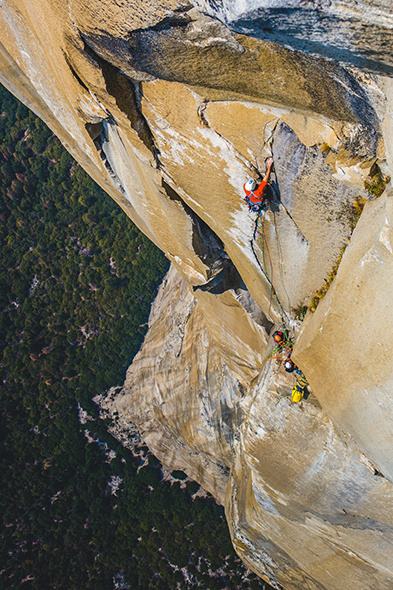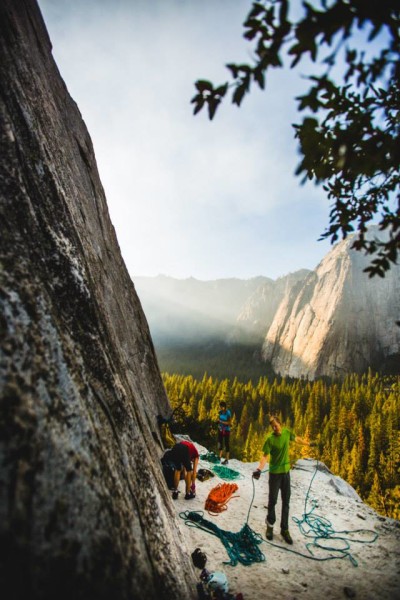By Jayme Moye
On Saturday September 12, Hans Florine climbed the Nose route on El Capitan in Yosemite National Park for the 100th time. The Nose, one of the most challenging climbs in the world, follows the massive prow of El Cap, a 3,000-foot sheer granite monolith. Florine’s accomplishment is a new world record in big-wall climbing. His ascent team included polar explorer Fiona Thornewill and myself. The effort took three days.
I sat down with Florine at his home in Yosemite the day after the feat to talk about life in the vertical world.
You currently hold the speed record on the Nose, with Alex Honnold, a blistering 2 hours and 23 minutes. What made you decide to take it “slow” for your 100th ascent?
Three days and two nights is kind of the standard time to ascend the Nose, and both of my partners, you, Jayme, and Fiona, were first time big wall climbers. I chose a time frame that was challenging, but attainable goal for them. For me, it’s hugely rewarding to see the Nose through the eyes of people experiencing it for the first time. The personal bond that’s forged is incredible. Not just in the pragmatic way, like peeing beside someone on a narrow ledge, but also emotionally because you’re pushing the edge of everything up there.

For most people, ascending the Nose is a once-in-a-lifetime adventure. How have you managed to pull off 100 ascents?
After the first in 1988, I remember tucking away the duffle bag I’d used as a haul bag, thinking I wouldn’t be doing any more big wall climbing. Back then, the Nose was just something I had to do, to prove my competency as a trad climber. It wasn’t something I planned on repeating. I thought of it more as vertical camping than climbing. It took going up the Nose with Steve Schneider in 1990 to understand that it can be an athletic pursuit. He was so adept at it. After we climbed together, I realized it’s possible to cover a huge amount of terrain quickly and efficiently. That really intrigued me. Then, when I started competing in Europe, so many people congratulated me on my speed record on the Nose—the one Peter Croft and I set in 1992—that it really drove it home to me that Yosemite is the center of the rock climbing universe; and that the Nose is the longest, tallest, coolest, big wall route in the world. That was, and still is, a powerful motivator for me.
Having ascended the Nose 100 times, does it ever get boring?
No. Climbing the Nose is different every time. There are so many places on the route for things to—I don’t want to say go wrong—so let’s say for new challenges to arise. Even when I set the speed record with Alex, it wasn’t a perfect ascent. We had a rope snag and I had to go down and get it. In that way, it’s a lot like life, at least with the big goals in life. You have to be willing not to let little setbacks set you back the whole way.
What’s your second favorite route up El Cap?
The Salathe. It starts just to the left of the Nose. Wait, maybe the Triple Direct, because it ends at the same place as the Nose. [Laughs]. You know, anything that shares a part with the Nose. In all seriousness, Salathe is cool because it follows cracks the whole way, so the line is really natural.

You’ve devoted 27 years of your life to climbing the Nose. Are you able to put into words what this route means to you?
It’s my base. I know that’s an interesting way to say it because I’m going up, vertically, but for me, climbing the Nose is grounding. I’ve never not been rewarded at the end of the Nose. I guess you can say it’s my rock. [Laughs]. Then there’s the fact that in every day life, when you drop something, you bend over and pick it up. If you drop something on the Nose, it’s gone forever. You can’t take your watch off, you can’t set your backpack down—you have to clip it in. You’re in this vertical world. And once you reach the top of the route, you get to switch that off. When I reach the tree at the top of the Nose, it’s like oh my god, I can set this haul bag down. I can take my harness off. It gives you this appreciation of how easy horizontal living is. I get back to my house and I can walk out onto the deck and don’t have to be clipped into the railing.
Your most determined competitor for the speed record on the Nose, Dean Potter, died in May, base jumping in Yosemite. How has that impacted your perspective of your sport?
It’s complicated. I don’t know a single person who, after saying what a huge bummer Dean’s death was—follow it up with “but I’m not surprised.” Dean was controversial. He did slacklining in big, crazy places and base jumped off things. He most likely had fun doing those things, or found them exhilarating, or spiritual, but ultimately he did them because they would get him attention. Climbing is no different than other sports in terms of how sponsorship works. Getting media attention is what allowed Dean to continue to be a sponsored climber. I don’t fault him for doing those things to get that media attention, but I do feel bad that he seemed to be so torn up inside about it. He didn’t stomach our competition over the speed record on the Nose so well either. As much as there was this angst in him about me, I don’t think we were as different as he thought we were. And if we climbed together, he would have seen that. I’m selfishly sad that we won’t ever get the chance to do that.
What’s next for you?
I’m going to go for 200 ascents on El Capitan. Climbing the Nose route for the 100th time put me at 160 total top outs on El Cap. There’s like 50 or 60 other routes, and I’ve only climbed 25 of them so far. I’m also writing a book, On the Nose: A Lifelong Obsession with Yosemite’s Most Iconic Big Wall Climb, which Falcon is publishing next summer.
Read the Full Story Here
